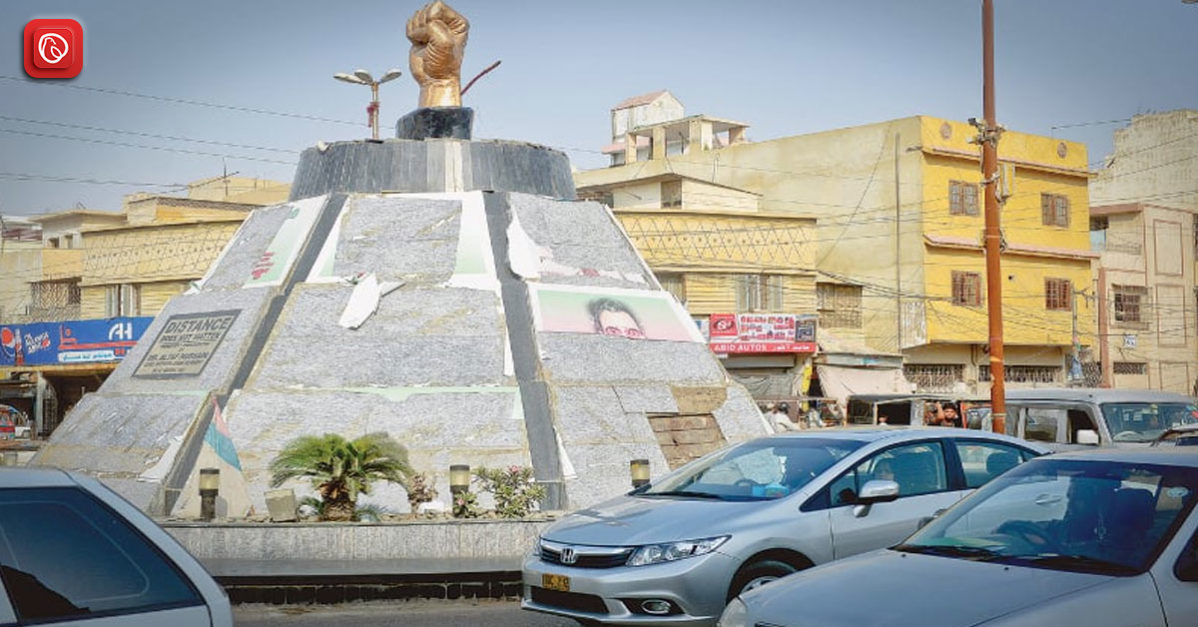
Mukka Chowk
Mukka Chowk, situated in the bustling neighbourhood of Azizabad in Karachi, is more than just a roundabout; it is a significant landmark that carries historical, cultural, and political connotations. This intersection, adorned with a sculpture of a clenched fist, symbolises strength, unity, and the political activism that has shaped the area’s identity.
In this blog, Graana.com will delve into the history, significance, and contemporary relevance of Mukka Chowk, exploring its impact on the local community and beyond.
Mukka Chowk, translating to “Fist Roundabout,” derives its name from the prominent sculpture of a clenched fist that stands at its centre. The monument was erected in the 1980s, during a period of significant political upheaval in Karachi. The clenched fist is a universal symbol of resistance and solidarity, representing the struggles and aspirations of the people in the area.
The fist sculpture at the chowk symbolises the party’s resolve and commitment to fighting for the rights of the Muhajir community, descendants of Urdu-speaking migrants who settled in Karachi after the partition of India in 1947.
The chowk is not merely a traffic intersection; it is a community hub where locals gather to socialise, discuss politics, and celebrate cultural events. The chowk’s central location makes it a convenient meeting point for residents of Azizabad and neighbouring areas. Over the years, it has become a symbol of local identity and pride.
The chowk has witnessed numerous celebrations, including political victories and cultural festivals. Conversely, it has also been a focal point for protests and demonstrations, reflecting the community’s engagement with socio-political issues. The vibrancy of Mukka Chowk mirrors the dynamic spirit of Karachi, a city known for its resilience and activism.
The most striking feature of Mukka Chowk is undoubtedly the fist sculpture. Crafted from metal, the sculpture is both imposing and inspiring. It stands as a testament to the enduring spirit of the local populace and their collective strength. The design, though simple, is powerful, capturing the essence of unity and resistance.
The chowk is surrounded by various commercial establishments, including shops, restaurants, and offices. These structures contribute to the area’s bustling atmosphere, making it a vibrant commercial hub. The constant flow of traffic and pedestrians adds to the lively ambiance, making Mukka Chowk a quintessential part of Karachi’s urban landscape.
Karachi, being a rapidly growing metropolis, has seen significant urban development in recent years. Mukka Chowk has adapted to these changes, with improvements in infrastructure and facilities enhancing its functionality. Despite these modernisations, the chowk has retained its historical and cultural essence, balancing progress with heritage.
Mukka Chowk plays a vital role in the local economy of Azizabad. The surrounding commercial activities generate significant economic activity, providing livelihoods for many residents. The shops and eateries attract customers from various parts of the city, contributing to the area’s economic vibrancy.
The area’s real estate market has also benefitted from the presence of Mukka Chowk. Properties in and around Azizabad have seen appreciation in value, partly due to the chowk’s prominence. This has attracted investors and developers, further boosting the local economy.
One of the primary challenges facing Mukka Chowk is traffic congestion. As a major intersection, it experiences heavy traffic flow, especially during peak hours. This congestion often leads to delays and inconvenience for commuters. Addressing this issue requires effective traffic management and infrastructural improvements.
While development is essential, preserving the historical and cultural significance of Mukka Chowk is equally important. Efforts must be made to maintain the site’s heritage while accommodating modernisation. This balance can be achieved through careful planning and community involvement.
Mukka Chowk stands as a powerful symbol in the heart of Azizabad, Karachi. Its history, marked by political activism and community engagement, reflects the spirit of the people who call this area home. As a landmark, it continues to inspire and unite, serving as a reminder of the struggles and triumphs that have shaped the local identity.
While challenges such as traffic congestion persist, the opportunities for economic growth and cultural preservation offer a promising future for the chowk and the community it represents.
Related FAQs
The fist sculpture at Mukka symbolises strength, unity, and resistance. It represents the political activism and solidarity of the local community, particularly the Muhajir population.
The Chowk, translating to “Fist Roundabout,” derives its name from the prominent sculpture of a clenched fist that stands at its centre. This sculpture symbolises the local community’s resolve and unity.
The Chowk is a commercial hub with various shops, restaurants, and offices. These establishments generate significant economic activity, providing livelihoods and contributing to the area’s economic vibrancy.
Chowk has seen infrastructural improvements to accommodate the city’s rapid growth. Despite modernisations, it has retained its historical and cultural essence, balancing progress with heritage.
The Chowk faces challenges such as traffic congestion, which can cause delays and inconvenience for commuters. Addressing this issue requires effective traffic management and infrastructural improvements while preserving the site’s cultural and historical significance.
For more details, visit the Graana blog.
Saudi Arabia’s Real Estate General Authority (REGA) has announced the launch of a new platform…
Dubai: Tomorrow World Group, a global enterprise with a 20-year presence in the emirate, has…
Islamabad: The Capital Development Authority has begun a citywide rehabilitation and upgrading campaign, starting…
Dubai: The emirate’s real estate sector continued its strong performance in November 2025, posting transactions…
The 19th Real Estate Development Summit Saudi Arabia Luxury Edition ended after two days of…
Dubai: Emaar Properties launched the Dubai Square project in May at Dubai Creek Harbour, bringing…